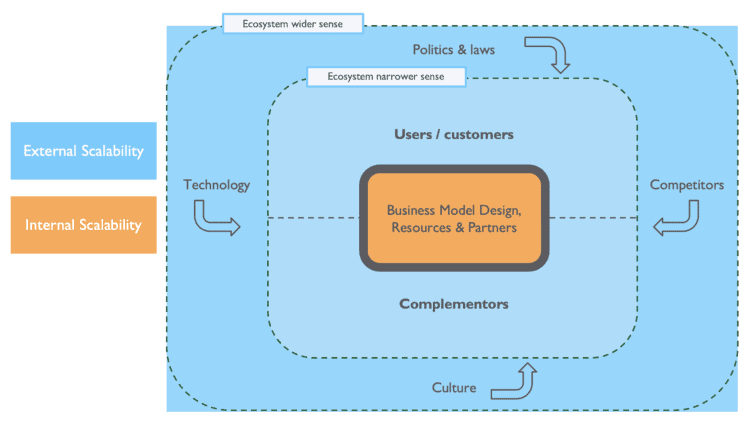A business model can be both scalable and unscalable at the same time because different aspects of a business can have different levels of scalability. For example, a company that manufactures physical products may have a scalable production process but a limited distribution channel that limits the overall scalability of the business. On the other hand, a company that provides a digital service may have a scalable product and a scalable distribution channel but limited scalability in terms of the number of customers it can serve at any given time.
In the early 2000s, traditional businesses such as PetroChina, Exxon, and General Electric had the highest revenue and market capitalization. By 2019, these companies had been surpassed by digital platforms such as Microsoft, Apple, Amazon, Alphabet, and Facebook.
Scalability played a key role in achieving the rapid and successful growth of these companies. A scalable business model is one that can be easily expanded to serve more customers or produce more products without requiring significant additional investments in infrastructure or resources. This allows companies to grow quickly and efficiently and can help them to achieve profitable and sustainable growth.
Scalability is particularly important in today's fast-paced business environment, where technology and market conditions can change rapidly. Companies that are able to adapt and scale their operations quickly are more likely to succeed in the long term. Therefore, scalability is an important factor in the success of a business because it allows the company to meet growing demand without incurring high additional costs.
Business Scalability
Scalability is the ability of a business model to grow, process and adapt to handle increasing demand, workload, and a number of customers without a decrease in performance or efficiency. A scalable business is able to maintain or improve its customer experience while increasing production and expanding into new markets.
There are three key characteristics of a scalable business; the efficient use of resources, the ability to withstand pressure, and the ability to thrive due to network effects. An efficient use of resources means that a company is able to achieve a high level of output with minimal input of resources. This includes things like time, money, and labor. Endurance under pressure refers to the ability of a company to maintain its performance and efficiency even when faced with unexpected challenges or an increase in demand. Network effects thriving means that the value of a company's product or service increases as more people use it. This can create a virtuous cycle where the more people use a product or service, the more valuable it becomes, which in turn attracts even more users. Network effects can be a powerful driver of scalability, as they can lead to exponential growth. By focusing on scalability, businesses can position themselves for long-term success and growth.
There are many factors that can affect the scalability of a business, and these can be grouped into internal and external factors. Internal scalability refers to the ability of a company's internal systems, processes, and resources to handle an increase in demand or workload. This includes things like the efficiency of production processes, the ability to hire and train new employees, and the ability to expand physical infrastructure. External scalability refers to the ability of a company to adapt to changes in external factors, such as changes in market demand, new competitors, or changes in regulation. Some common ways that companies can improve the scalability of their business include automating processes, outsourcing certain tasks, and investing in new technology.
Scalability Drivers
To create a business model that can handle growth and adapt to changes in demand, it is important to understand the factors contributing to scalability. There are four key drivers of scalability that businesses should consider when designing their business models: A light asset base, automated processes, low-cost labor, and the ability to be easily replicated in different locations or markets. By focusing on these drivers, companies can create flexible and adaptable systems that can handle growth and changes in demand. This will enable them to scale up or down as needed, positioning them for long-term success and growth.
A light asset base is a business model that relies on minimal physical assets, such as manufacturing equipment or retail space. This can make it easier for a company to scale up or down as needed, as it is not tied to a large number of fixed assets. Automated processes can also improve scalability, as they can reduce the need for labor and make it easier to scale up production. Low-cost labor can also be a driver of scalability, as it allows a company to increase production without incurring significant additional costs. Preparing for replication refers to the ability of a business model to be easily replicated in new locations or markets. By designing their business models with these drivers in mind, companies can create scalable systems that can adapt to changes in demand or the market.
Danger of Scalability
Scalability is not always the best approach for every business, and it can have some drawbacks. Rapid scaling can lead to a decline in quality, which can hurt customer satisfaction and the company's reputation. Additionally, scalable businesses are often simpler in nature, which can make it easier for new competitors to enter the market and challenge established companies. It's important to carefully consider whether scalability is the right approach for your business and to make sure that you are scaling in response to growth rather than trying to use scaling to drive growth on its own.
Scalability Patterns
Some people see scalability as a company's ability to expand into new markets or regions. Others see it as the ability to replicate the business in other areas or product categories. Some people even see scalability as a way to reduce operational costs while increasing production and the customer base. Although each organization has its own approach to scalability, successful businesses often follow these five patterns when developing a scalable business model:
Multiple Distribution Channels
Adding new distribution channels can be a very effective way for a company to reach new customers and increase its sales, but it's important to do so strategically to avoid cannibalizing sales from the existing channels. It's also important to consider the cost of adding new distribution channels and whether or not the expected increase in sales will be enough to offset those costs. In general, a company should aim to spread its overhead costs across as many channels as possible in order to lower its overall costs and increase its profitability.
Elimination of Capacity Limitations
Capacity constraints can be a major challenge for businesses as they try to scale. Capacity constraints can take many forms and may include challenges related to scaling manpower, capital, warehousing, systems, technology, or capacity. Some common ways that businesses try to overcome these constraints include automation, outsourcing, and optimizing their supply chain. Automation can help to reduce the need for labor, freeing up capacity and allowing the business to scale more easily. Outsourcing can also help to reduce the burden on in-house resources, allowing the business to focus on its core competencies. Optimizing the supply chain can help to reduce waste and increase efficiency, freeing up capacity and making it easier to scale. Additionally, businesses may also consider expanding their physical infrastructure or implementing new technology to increase their capacity.
Outsource Capital Investments
It is not uncommon for businesses to face funding challenges as they try to scale. One way that businesses can overcome this challenge is by developing a business model that creates open platforms and allows them to collaborate with strategic partners. This can provide access to additional capital resources and help the business to scale more effectively. Other options for overcoming funding challenges include seeking investment from venture capitalists, obtaining loans or lines of credit, and using crowdfunding platforms. Businesses need to carefully consider their options and choose the approach that best fits their needs and goals.
Leverage Partner Expertise
Strategic partnerships can be an effective way for businesses to improve their value proposition and better meet the needs of their customers. By working closely with partners who have complementary skills and resources, businesses can create offerings that are more comprehensive and competitive. It is important for businesses to be thoroughly aware of their customer's desires, needs, and demands in order to identify potential partners and develop effective partnerships. This can involve conducting market research, gathering customer feedback, and keeping up-to-date with industry trends. By doing so, businesses can find creative ways to leverage the skills and resources of their partners to create value for their customers.
Create Platform Models
Platform-based business models can be a powerful way for companies to scale by creating a space where multiple parties can come together and interact. Platforms can be a way for companies to invite their competitors to share in the benefits of the platform rather than competing directly with one another. This can be particularly effective in industries where there is a high degree of fragmentation and many small players. By creating a platform that allows these players to come together and collaborate, companies can create a virtuous circle of growth and scalability.
Internal and External Business Model Scalability
Scaling a business can be a complex process that requires the support and coordination of multiple departments and stakeholders within the organization. Internal scalability refers to the ability of a company to expand its customer base and increase sales quickly while maintaining the quality of its products or services. This can depend on factors such as the business model design, the resources available to the company, and the partnerships it has established. External scalability, on the other hand, refers to the suitability of the external business environment for scaling the business. This can include factors such as the target market's size and growth potential, the competition level, and the regulatory environment. Both internal and external scalability are important considerations for businesses as they look to grow and expand. Companies can create a solid foundation for sustainable growth and scalability by focusing on both.
Strategies Improving Internal Scalability
In order to achieve growth, businesses must come up with strategies that are tailored to their industry and type of company. It is crucial for businesses to find the strategy that works best for them in order to achieve scalability.
Leverage External Resources
There are often many resources available outside a company that can be utilized to help it grow and scale. Being resourceful and finding creative ways to access these resources can be key to success. Outsourcing can also help a company increase its financial liquidity by reducing overhead costs, increasing efficiency, and freeing up capital that can be used for other purposes. By partnering with other producers or using external resources, a company can focus on its core competencies and avoid investing in expensive infrastructure or hiring additional staff. Leveraging external resources can also allow a company to access specialized expertise or technologies that it may not have in-house.
Digital platforms that leverage external resources can be highly scalable because they can access a large pool of resources and scale up or down quickly and efficiently as demand changes. For example, companies like Uber and Airbnb have been able to scale rapidly by using digital platforms to connect people who need a ride or a place to stay with drivers or homeowners who have those resources to offer. This model allows these companies to expand into new markets and serve more customers without investing in costly infrastructure or hiring additional employees.
Digitize and Automate
Digitization and automation can be powerful tools for businesses looking to expand and scale their operations. By using technology to streamline processes and reduce the need for manual labor, companies can increase efficiency and reduce costs, which can make it easier to scale up and enter new markets.
Automation in particular has played a major role in enabling economies of scale in manufacturing by allowing companies to produce goods more efficiently and at a lower cost. Automation can take many forms, including the use of robotics, computer-controlled machines, and artificial intelligence (AI). By automating certain tasks, companies can reduce their reliance on labor, improve the speed and accuracy of their production processes, and reduce the need for costly manual labor.
In the coming years, it is expected that automation will continue to play a major role in manufacturing. AI and machine learning are making it easier than ever before to automate tasks and reduce human dependencies. These technologies can be used to optimize manufacturing processes, improve quality control, and predict and prevent equipment failures, among other things.
Develop and Monitor a Growth Cycle
A virtuous cycle of growth, also known as a flywheel, is a self-reinforcing cycle in which improvements in a company's offer lead to benefits for both the company and its customers, which drives further improvements and growth. The key to a virtuous growth cycle is the presence of positive feedback loops, in which the benefits of an improvement reinforce and amplify each other, creating a growth spiral. By focusing on creating a positive experience for all of the user groups, businesses can create a virtuous cycle of growth that helps to scale effectively.
For example, if a company improves its product or service in a way that benefits its customers, those customers may be more likely to buy from the company again and recommend it to others. This can lead to increased sales and revenue for the company, which in turn can be reinvested in further improvements to the product or service, creating a self-reinforcing cycle of growth. To create a virtuous cycle of growth, companies need to focus on continually improving their offer and on meeting the needs and expectations of their customers.
Find the Right People to Scale
Some people are better able to handle uncertainty and instability than others. It’s important to recognize that everyone has their own strengths and weaknesses and that it's possible for people to develop the skills and mindset needed to thrive in a dynamic and uncertain environment. In terms of building a scalable business, it's often a good idea to have a team made up of people with a variety of skills and experiences, as this can help the team adapt and respond effectively to changing circumstances.
Venture capitalists often emphasize the importance of the team when evaluating potential investments, as they recognize that the team is the driving force behind any business. When building a team, it's important to consider not just the individual skills and experience of team members but also their values, needs, and personalities, as these can all have an impact on how well the team functions as a whole. By carefully selecting team members who are well-suited to the demands of scaling a business, you can set the foundation for success and help your company to grow and thrive.
It's also important to establish a clear workplace ethic and culture, as this can help to ensure that everyone is working towards the same goals and operating with the same level of professionalism and integrity. By taking the time to carefully build and cultivate a team with the right mindset, skillset, and ethics, you can set the foundation for a successful and scalable business.
Strategies Improving External Scalability
When it comes to scaling a business, it's critical to consider not only internal factors but also external factors that can impact the project's success. Understanding external scalability means understanding the larger context in which your business operates. By taking these external factors into account, you can develop strategies that are more likely to succeed and ensure that your business is well-positioned to thrive in the long term.
Pick a Big and Growing Market
It can be challenging to decide whether to enter an established market or a newer, potentially growing market. Both options have their own pros and cons, and the decision ultimately depends on a variety of factors, including the strengths of your company, the resources you have available, and your appetite for risk.
Entering an established market can be appealing because there is already a demand for the products or services you offer, and you may be able to tap into existing distribution channels and customer relationships. However, there may also be a lot of competition, which can make it difficult to differentiate your offering and gain a foothold in the market.
On the other hand, entering a newer or growing market can be exciting because it offers the potential for significant growth and the opportunity to pioneer the industry. However, it can also be risky, as there may be less demand for your products or services, and you may have to spend more time and resources building awareness and educating potential customers about your offering.
Ultimately, the decision to enter a particular market should be based on a thorough analysis of these and other relevant factors, as well as a clear understanding of your company's goals and resources.
Target the Right Customers the Right Way
Develop a solution that fits the needs and preferences of your target market, as this can help to increase customer satisfaction and loyalty. It's important to prioritize customer satisfaction in order to build a loyal customer base and maintain a positive reputation for your business. Good customers are those who are willing to invest in your products or services and provide valuable feedback that can help your business improve and grow. It's generally better to have a smaller number of satisfied customers than a larger number of unhappy ones.
One way to encourage customer loyalty and advocacy is to offer rewards and referrals. By offering incentives for customers to refer their friends and family to your business, you can help to build a strong network of satisfied customers who are willing to promote your brand. This can be a powerful tool for driving growth, especially in the early stages of a company's development. It's also important to listen to customer feedback and make an effort to address any concerns or issues they may have, as this can help to improve the overall customer experience and increase satisfaction.
Look for Market Constraints
It's important for companies to carefully consider which markets are the best fit for their brand and to thoroughly assess the potential restraints and barriers that may exist in those markets. Expanding into new markets can be challenging due to various barriers such as language and cultural differences, regulations, and local technology. However, with careful planning and strategic thinking, it is possible to overcome these barriers and successfully expand into new markets. To overcome these barriers, companies can use a variety of strategies, such as localizing products and services, establishing partnerships, leveraging technology, and investing in market research.
Do Something Relevant
Having a higher purpose or a clear mission that goes beyond just selling products or services can be a powerful motivator for a company and can help it attract talented employees. A higher purpose can also help a company differentiate itself in the marketplace and contribute to its long-term success. In addition to attracting talented employees and differentiating the company in the marketplace, a higher purpose can help a company stay motivated and focused, especially when faced with challenges or setbacks. It can help attract and retain talented employees who are passionate about the company's mission. Having a clear sense of purpose can provide a sense of direction and meaning, which can help a company stay motivated and continue working towards its goals.
In today's business environment, many high-potential employees are looking for companies that have a clear purpose and are working to solve big challenges. By having a higher purpose, a company can differentiate itself in the marketplace and appeal to this type of talent. It can also help the company build trust and customer loyalty, as customers are increasingly looking for brands that align with their values and that are working towards a bigger purpose.
Conclusion
When developing a scalable business model, it's important to focus on both internal and external scaling. Internal scaling involves optimizing processes and systems within the company to increase efficiency and effectiveness. This can include things like streamlining operations, automating tasks, and improving processes to reduce waste and increase productivity. External scaling involves expanding the company's reach and customer base. This can include things like entering new markets, launching new products or services, and increasing marketing efforts to reach a wider audience.
If one side of scalability is weak, it can limit the company's growth potential. It's important to focus on both internal and external scaling to ensure that a company is well-equipped to handle growth and is able to achieve long-term success.
References
What does Business Model Scalability Mean?
Patterns of Business Model Scalability








